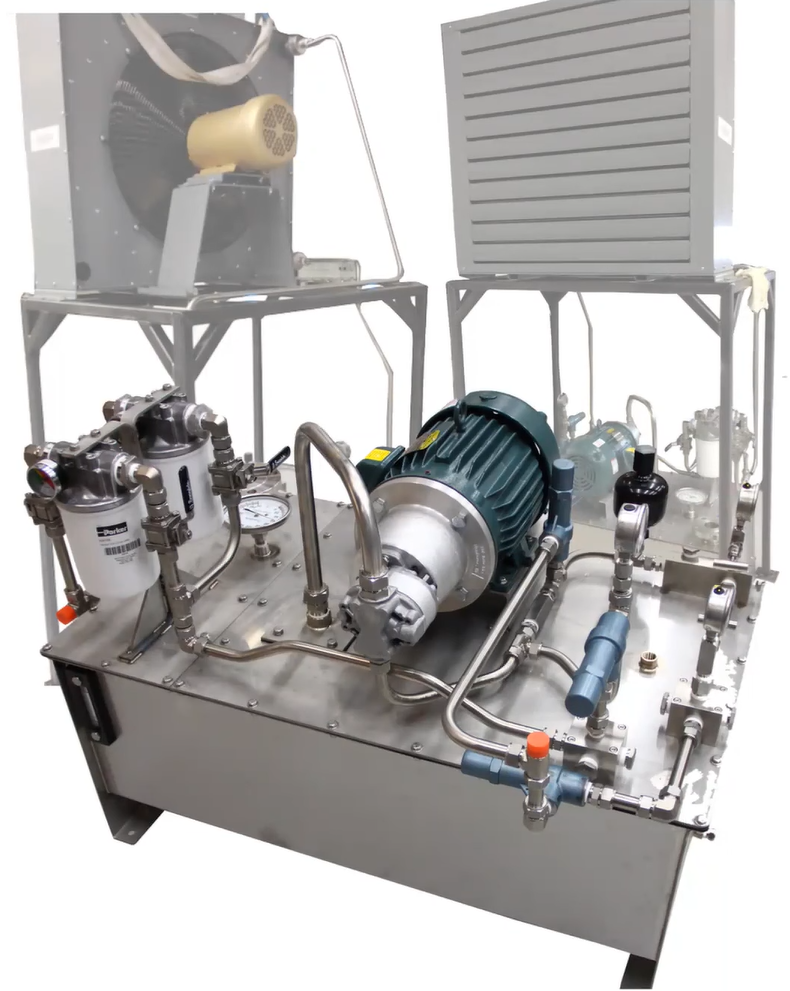Share this
Wondering Which Seal Support Systems to Use? Options for Northern Alberta Refineries
by Tristian McCallion on Thu, Aug 19, 2021 @ 13:08 PM

Northern Alberta refineries depend on seal support systems for safe and efficient pump operation. API 682 defines a multitude of seal flush plans and their use cases—but even when you know which seal support system to use, there are critical design considerations that can impact your system’s performance.
To ensure mechanical seals perform efficiently and reliably, it is important to select the right seal support systems to use for the process conditions and optimize the components and layout for those conditions. Below, we’ll look at some of the most common seal support systems to use in Northern Alberta refineries and how Edmonton Valve & Fitting’s expert Field Advisors can help you get the most efficiency and functionality out of them.
Common Seal Support Systems to Use in Northern Alberta
A seal support system provides cooling and lubrication to a mechanical seal to protect it from friction and heat. For corrosive, viscous, or harsh process fluids, the seal support system may also protect the seal from the process fluid using a buffer or barrier fluid. The American Petroleum Institute (API) has standardized seal support plans in API Standard 682: Pumps—Shaft Sealing Systems for Centrifugal and Rotary Pumps.
For Northern Alberta refineries, there are a variety of seal support systems to use depending on process conditions. Some of the most common plans are:
- Plans 11 and 12 are simple, process-side seal support systems adequate for general applications using relatively clean fluids like water.
- Plan 32 provides an external flush fluid, usually water, to the process side of the seal and is often used when the process fluid is unsuitable for flushing the seal.
- Plans 52 and 55 flush a dual seal arrangement with a buffer fluid (an unpressurized flush), which protects the seal without contaminating the process fluid.
- Plans 53A, 53B, 53C, and 54 flush a dual seal with a barrier fluid (pressurized flush), which ensures no process fluid contaminates the seal.
The table below describes these seal support systems in more detail.
| API 682 Flush Plan | Description | Flush Location | Applications |
| Plan 11 | Process fluid recirculates from the pump discharge through a flow control orifice to a single mechanical seal. | Process side | Adequate for most general applications with non-polymerizing fluids and sufficient pressure. |
| Plan 12 | Process fluid recirculates from the pump discharge through a strainer and flow control orifice to a single seal. | Process side | Similar to Plan 11, but with a strainer to remove solid particles from contaminated fluids. |
| Plan 32 | Clean fluid from an external source is pressurized through a throat bushing and delivered to a single seal. | Process side | Used when the process fluid is unsuitable for flushing the seal because it contains solids or contaminants. |
| Plan 52 | Clean buffer fluid is delivered from a reservoir to the outboard seal face in a dual seal arrangement. | Dual seal | Used when contamination of the process fluid with a barrier fluid is unacceptable. |
| Plan 53A, 53B, 53C | Clean, pressurized barrier fluid is delivered to the inboard and outboard seal faces from a reservoir (53A), bladder accumulator (53B), or piston accumulator (53C). | Dual seal | Used for dirty, abrasive, or polymerizing process fluids that would damage the seal faces or flush system, or when leakage of the process fluid into the atmosphere is unacceptable. |
| Plan 54 | Clean, pressurized barrier fluid is delivered to the inboard and outboard seal faces from an external source. | Dual seal | Used when the process fluid is hot or contaminated with solids or when the pumping ring is unable to supply a sufficient flow rate. |
| Plan 55 | Clean, unpressurized buffer fluid is delivered to the inboard and outboard seal faces from an external source. | Dual seal | Used when the process fluid may solidify when exposed to the atmosphere or when additional heat removal from the inner seal is required. |
How to Get the Most Out of Your Seal Support System
Your seals, process fluids, and the rest of your process details determine which types of seal support systems to use—but there are other choices that can affect the system’s efficiency and functionality. For example, using tubing instead of piping provides benefits like more uniform wall thickness and better surface finish, making it a better choice than piping for corrosive fluids.
API 682 provides the basic layout for your seal support system, but there is a big difference between a professionally designed, quality system optimized for your process and a basic one assembled from the cheapest parts. A well-designed seal support system will be carefully planned with all the important components arranged on a clean, easy-to-use panel. There are many options available for components like tubing, fittings, instrumentation, and valves. The best components for a given system depend on the process details and available infrastructure.
For instrumentation, it’s a good idea to choose components and arrange them to provide the most information possible. Pressure and temperature gauges should be strategically placed to monitor for changes in critical locations, such as the seal chamber, seal pots.
Relying on a visual gauge alone is better than nothing, but automation can make systems safer and more effective. Pressure gauges with transmitters can be set to trigger an alarm when the pressure exceeds a certain amount—for example, in seal pots where high pressure usually indicates a leak.
Local Seal Support System Experts Can Help
If you still have questions about which seal support systems to use, Edmonton Valve & Fitting can help. Our Field Advisors are experts in API 682 implementation for Northern Alberta refineries and will make sure you get the seal support solution you need. We can perform an onsite assessment to understand your process details, including fluid characteristics, reviewing your pump rate, seal design, and facility layout. Then, we create the technical specifications for your seal support system.
In addition to determining the best seal support systems to use for your process, our Field Advisors can make specific recommendations regarding panel layout, instrumentation, and custom components to boost efficiency and reliability. Our goal is to ensure you have the best possible seal support system for your needs.
We build our seal support systems locally, so you get what you need quickly. We test all systems thoroughly to validate safety, reliability, and ease of maintenance. All our products are backed by Swagelok’s Limited Lifetime Warranty—one of the strongest in the industry.
About Tristian McCallion, Custom Solutions Manager, Edmonton Valve
 Edmonton Valve has relied on McCallion for 26 years. His current title is Custom Solutions Manager. Earlier, he supervised our sales team. Before that, he managed sales throughout Edmonton and northeastern Alberta. For 12 years he also worked with Swagelok Energy Advisors across North America, training customers on steam fundamentals (TAP), testing steam traps, and conducting steam system audits.
Edmonton Valve has relied on McCallion for 26 years. His current title is Custom Solutions Manager. Earlier, he supervised our sales team. Before that, he managed sales throughout Edmonton and northeastern Alberta. For 12 years he also worked with Swagelok Energy Advisors across North America, training customers on steam fundamentals (TAP), testing steam traps, and conducting steam system audits.
Share this
- Fittings (82)
- Cost Savings (70)
- Valves (67)
- Fabrication (59)
- Services (41)
- Videos (33)
- Steam Systems (29)
- Training (27)
- Downloads (25)
- Resources (25)
- Sampling (24)
- Tubing (24)
- Field Advisors (18)
- Hoses (12)
- Oil & Gas (10)
- Regulators (9)
- Winterization (9)
- Gas Distribution (7)
- Hydrogen & Clean Energy (4)
- About Us (2)
- Measurement (2)
- February 2025 (1)
- November 2024 (1)
- October 2024 (2)
- August 2024 (1)
- July 2024 (1)
- June 2024 (4)
- April 2024 (4)
- March 2024 (2)
- January 2024 (3)
- December 2023 (2)
- November 2023 (3)
- October 2023 (2)
- September 2023 (3)
- August 2023 (3)
- July 2023 (3)
- June 2023 (2)
- May 2023 (4)
- April 2023 (2)
- March 2023 (2)
- February 2023 (3)
- January 2023 (2)
- December 2022 (1)
- November 2022 (1)
- October 2022 (2)
- September 2022 (5)
- August 2022 (3)
- July 2022 (6)
- June 2022 (4)
- May 2022 (3)
- April 2022 (1)
- March 2022 (2)
- February 2022 (3)
- January 2022 (4)
- December 2021 (4)
- November 2021 (6)
- October 2021 (3)
- September 2021 (5)
- August 2021 (9)
- July 2021 (5)
- June 2021 (7)
- May 2021 (7)
- April 2021 (4)
- March 2021 (3)
- February 2021 (3)
- January 2021 (2)
- December 2020 (3)
- November 2020 (3)
- October 2020 (2)
- September 2020 (3)
- August 2020 (3)
- July 2020 (3)
- June 2020 (3)
- May 2020 (3)
- April 2020 (2)
- March 2020 (3)
- February 2020 (3)
- January 2020 (3)
- December 2019 (2)
- November 2019 (3)
- October 2019 (3)
- September 2019 (2)
- August 2019 (3)
- July 2019 (2)
- June 2019 (2)
- May 2019 (3)
- April 2019 (3)
- March 2019 (3)
- February 2019 (2)
- January 2019 (3)
- December 2018 (2)
- November 2018 (2)
- October 2018 (4)
- September 2018 (2)
- August 2018 (3)
- July 2018 (3)
- June 2018 (2)
- May 2018 (4)
- April 2018 (3)
- March 2018 (3)
- February 2018 (3)
- January 2018 (4)
- December 2017 (1)
- November 2017 (4)
- October 2017 (4)
- September 2017 (4)
- August 2017 (5)
- July 2017 (3)
- June 2017 (4)
- May 2017 (4)
- April 2017 (3)
- March 2017 (5)
- February 2017 (4)
- January 2017 (4)
- December 2016 (3)
- November 2016 (3)
- October 2016 (4)
- September 2016 (3)
- August 2016 (4)
- July 2016 (2)
- June 2016 (2)
- May 2016 (2)
- April 2016 (4)
- March 2016 (2)
- February 2016 (3)
- January 2016 (4)
- December 2015 (4)
- November 2015 (4)
- October 2015 (5)
- September 2015 (2)
- August 2015 (4)
- July 2015 (5)
- June 2015 (2)
- May 2015 (3)
- April 2015 (5)
- March 2015 (3)
- February 2015 (4)
- January 2015 (3)
- December 2014 (5)
- November 2014 (4)
- October 2014 (4)
- September 2014 (4)
- August 2014 (4)
- July 2014 (5)
- June 2014 (4)
- May 2014 (4)
- April 2014 (5)
- March 2014 (4)
- February 2014 (4)
- January 2014 (4)
- December 2013 (3)
- November 2013 (4)
- October 2013 (5)
- September 2013 (4)
- August 2013 (5)
- July 2013 (4)
- June 2013 (3)
- May 2013 (4)
- April 2013 (5)
- March 2013 (2)
- February 2013 (3)
- January 2013 (5)
- December 2012 (3)
- November 2012 (3)
- October 2012 (5)
- September 2012 (3)
- August 2012 (4)
- July 2012 (4)
- June 2012 (1)



